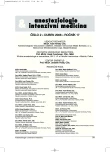-
Medical journals
- Career
Renal replacement therapy in critically ill patients: 2005 update
Authors: I. Novák; M. Matějovič; A. Kroužecký; J. Raděj
Authors‘ workplace: Jednotka intenzivní péče I. interní kliniky, Fakultní nemocnice a Lékařská fakulta UK, Plzeň
Published in: Anest. intenziv. Med., 17, 2006, č. 2, s. 99-101
Category: Intensive Medicine
Overview
Renal replacement therapy (RRT) is needed in 50% to 70% of patients with sepsis-related acute renal failure (ARF) in the ICU. The ARF in this setting is often accompanied by multiple organ dysfunction and is associated with very high mortality (53% to 73%). Thus, there is a great deal of interest in developing renal replacement strategies to reduce the mortality rate.Traditional intermittent haemodialysis in the treatment of ARF offers good metabolic control but poor haemodynamic tolerance, especially in septic patients. Haemofiltration is the more commonly used method in septic shock due to its better haemodynamic tolerance, and it is argued that haemofiltration can reverse the sepsis-related inflammatory response, even in the absence of ARF.This emphasises the potential role of the early initiation of haemofiltration in sepsis. Some new developments in blood purification for sepsis, including high-flux haemofiltration, high-volume haemofiltration, and the use of sorbents, remain under investigations. Current evidence is insufficient to draw strong conclusions regarding the method of RRT for ARF in septic patients.
Key words:
acute renal failure – sepsis – multiple organ failure – haemopurification – haemofiltration
Labels
Anaesthesiology, Resuscitation and Inten Intensive Care Medicine
Article was published inAnaesthesiology and Intensive Care Medicine

2006 Issue 2-
All articles in this issue
- What was new in general anaesthesia last year? Literature review
- New developments in regional anaesthesia in 2005
- Cardiac anaesthesia in 2005
- What’s new in the pharmacotherapy of pain?
- Vasopressors in septic shock – 2005 update
- Progress in the pathophysiology and therapy of ventilatory failure in critically ill patients
- Progress in the prevention, diagnosis and therapy of nosocomial ventilatory pneumonia in 2005
- Renal replacement therapy in critically ill patients: 2005 update
- Metabolism, endocrinology, and nutrition: Progress in 2005
- Therapy of brain injury
- Echocardiography in the critically ill patient
- Guidelines 2005: What is different compared with Guidelines 2000?
- Anaesthesiology and Intensive Care Medicine
- Journal archive
- Current issue
- Online only
- About the journal
Most read in this issue- Vasopressors in septic shock – 2005 update
- What’s new in the pharmacotherapy of pain?
- Echocardiography in the critically ill patient
- Renal replacement therapy in critically ill patients: 2005 update
Login#ADS_BOTTOM_SCRIPTS#Forgotten passwordEnter the email address that you registered with. We will send you instructions on how to set a new password.
- Career

